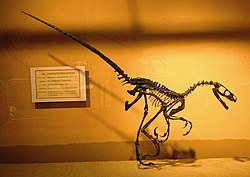Saurornitholestes
|
Saurornitholestes Temporal range: Late Cretaceous, 77–69 Ma |
|
|---|---|
 |
|
| Mounted skeleton, Museum of the Rockies | |
| Scientific classification | |
| Kingdom: | Animalia |
| Phylum: | Chordata |
| Class: | Reptilia |
| Clade: | Dinosauria |
| Order: | Saurischia |
| Suborder: | Theropoda |
| Family: | †Dromaeosauridae |
| Clade: | †Eudromaeosauria |
| Genus: |
†Saurornitholestes Sues, 1978 |
| Type species | |
|
†Saurornitholestes langstoni Sues, 1978 |
|
| Species | |
|
|
| Synonyms | |
|
|
Saurornitholestes ("lizard-bird thief") is a genus of carnivorous dromaeosaurid theropod dinosaur from the late Cretaceous of Alberta, Montana and New Mexico.
Two species have been named: Saurornitholestes langstoni in 1978 and Saurornitholestes sullivani in 2015. Saurornitholestes was a small bipedal meat-eating dinosaur, equipped with a sickle-claw on the foot.
Like other theropods in the Dromaeosauridae, Saurornitholestes had a long, curving, blade-like claw on the second toe. Saurornitholestes was more long-legged and lightly built than other dromaeosaurids such as Velociraptor and Dromaeosaurus. It resembles Velociraptor in having large, fanglike teeth in the front of the jaws. Saurornitholestes most closely resembles Velociraptor, although the precise relationships of the Dromaeosauridae are still relatively poorly understood.
Saurornitholestes was about 1.8 m (5.9 ft) long and weighed approximately 10 kg (22 lb). At the hip it stood 0.6 meters (2 feet), or around as tall as the length of a terrier.
Saurornitholestes sullivani is thought to have had a keen sense of smell, due to its skull suggesting an unusually large olfactory bulb.
In 1974 Canadian amateur paleontologist Irene Vanderloh discovered the skeleton of a small theropod near Steveville in Alberta. She showed it to John Storer of the Provincial Museum of Alberta, who brought it to the attention of Hans-Dieter Sues. In 1978 Sues named and described the specimen as the type species Saurornitholestes langstoni. The generic name is in reference to the Saurornithoididae, due to the resemblance with this group that is today seen as part of the Troodontidae, and combines their name with a Greek lestes, "thief". The specific name honours Wann Langston, Jr.
...
Wikipedia
